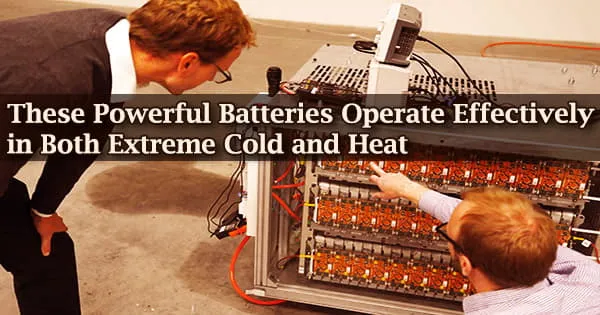University of California San Diego engineers have created lithium-ion batteries that are highly energy dense and work well in both extreme cold and extreme heat. The scientists achieved this accomplishment by creating an electrolyte that is both compatible with a high-energy anode and cathode and adaptable and resilient throughout a broad temperature range.
In an article published the week of July 4 in Proceedings of the National Academy of Sciences (PNAS), temperature-resilient batteries are described.
According to Zheng Chen, a professor of nanoengineering at the UC San Diego Jacobs School of Engineering and senior author of the study, such batteries could enable electric vehicles to travel farther on a single charge in cold climates and they could also lessen the need for cooling systems to prevent the battery packs of the vehicles from overheating in hot climates.
“You need a high-temperature operation in areas where the ambient temperature can reach the triple digits and the roads get even hotter. In electric vehicles, the battery packs are typically under the floor, close to these hot roads,” explained Chen, who is also a faculty member of the UC San Diego Sustainable Power and Energy Center.
“Also, batteries warm up just from having a current run through during operation. If the batteries cannot tolerate this warmup at high temperature, their performance will quickly degrade.”
The proof-of-concept batteries tested at -40 and 50 C (-40 and 122 F), respectively, retained 87.5% and 115.9% of their energy capacity. Additionally, at these temperatures, they showed high Coulombic efficiencies of 98.2% and 98.7%, respectively, which suggests the batteries can go through more charge and discharge cycles before they lose their functionality.
Because of their electrolyte, the batteries created by Chen and colleagues can withstand both heat and cold. It is constructed from a liquid dibutyl ether solution combined with a lithium salt. Dibutyl ether has a unique property in that its molecules have a weak affinity for lithium ions.
If you want a battery with high energy density, you typically need to use very harsh, complicated chemistry. High energy means more reactions are happening, which means less stability, more degradation. Making a high-energy battery that is stable is a difficult task itself trying to do this through a wide temperature range is even more challenging.
Professor Zheng Chen
In other words, as the battery charges and discharges, the electrolyte molecules can easily release the lithium ions. Scientists had previously shown that this weak chemical connection enhances battery performance at extremely low temperatures. Plus, dibutyl ether can easily take the heat because it stays liquid at high temperatures (it has a boiling point of 141 C, or 286 F).
Stabilizing lithium-sulfur chemistries
This electrolyte is unique in that it can be used with a lithium-sulfur battery, a class of rechargeable battery that uses sulfur as the cathode and lithium metal as the anode.
Because they promise higher energy densities and cheaper costs, lithium-sulfur batteries are a crucial component of next-generation battery technology. The range of electric vehicles might be doubled without any increase in the weight of the battery pack thanks to their ability to store up to two times as much energy per kilogram as current lithium-ion batteries.
Sulfur is also more accessible and more plentiful than cobalt, which is utilized in conventional lithium-ion battery cathodes. However, lithium-sulfur batteries have issues.
The anode and cathode are equally highly reactive. Because they are so reactive, sulfur cathodes disintegrate during battery operation. High temperatures make this problem worse.
Additionally, lithium metal anodes are prone to developing dendrites, which are needle-like formations that can penetrate the battery and lead to a short circuit. Lithium-sulfur batteries therefore only have a limited lifespan of ten cycles.
“If you want a battery with high energy density, you typically need to use very harsh, complicated chemistry,” said Chen. “High energy means more reactions are happening, which means less stability, more degradation. Making a high-energy battery that is stable is a difficult task itself trying to do this through a wide temperature range is even more challenging.”
These problems are avoided even at very high and very low temperatures by the dibutyl ether electrolyte created by the UC San Diego team. In comparison to a standard lithium-sulfur battery, the batteries they tested had significantly longer cycling lives.
“Our electrolyte helps improve both the cathode side and anode side while providing high conductivity and interfacial stability,” said Chen.
The team also added a polymer graft to the sulfur cathode to make it more stable. This keeps the electrolyte from becoming more sulfur-filled.
The battery chemistry will next be scaled up, improved to function at even greater temperatures, and given a longer cycle life.
Paper: “Solvent selection criteria for temperature-resilient lithium-sulfur batteries.” Co-authors include Guorui Cai, John Holoubek, Mingqian Li, Hongpeng Gao, Yijie Yin, Sicen Yu, Haodong Liu, Tod A. Pascal, and Ping Liu, all at UC San Diego.
This work was supported by an Early Career Faculty grant from NASA’s Space Technology Research Grants Program (ECF 80NSSC18K1512), the National Science Foundation through the UC San Diego Materials Research Science and Engineering Center (MRSEC, grant DMR-2011924), and the Office of Vehicle Technologies of the U.S. Department of Energy through the Advanced Battery Materials Research Program (Battery500 Consortium, contract DE-EE0007764).
This work was performed in part at the San Diego Nanotechnology Infrastructure (SDNI) at UC San Diego, a member of the National Nanotechnology Coordinated Infrastructure, which is supported by the National Science Foundation (grant ECCS-1542148).





